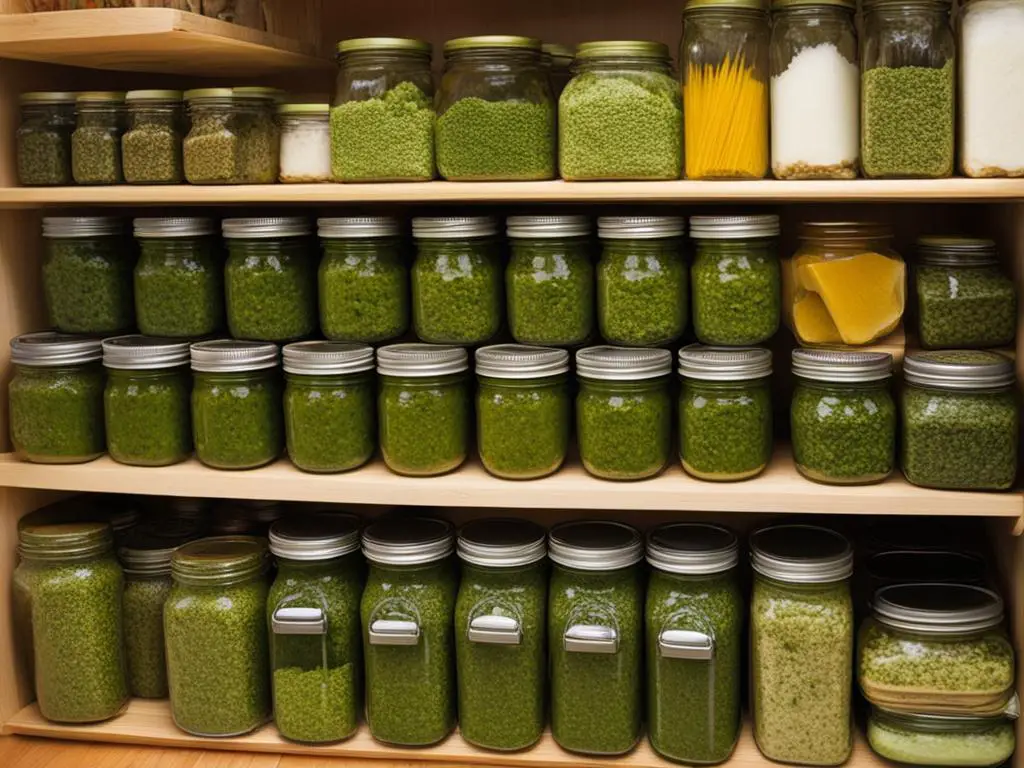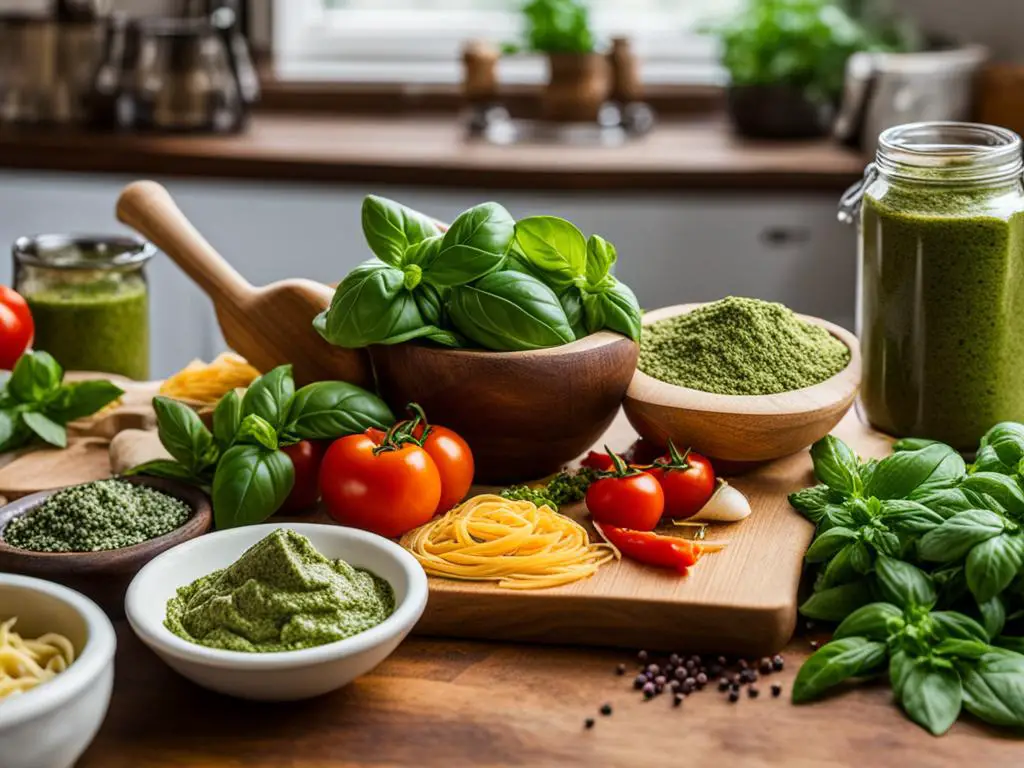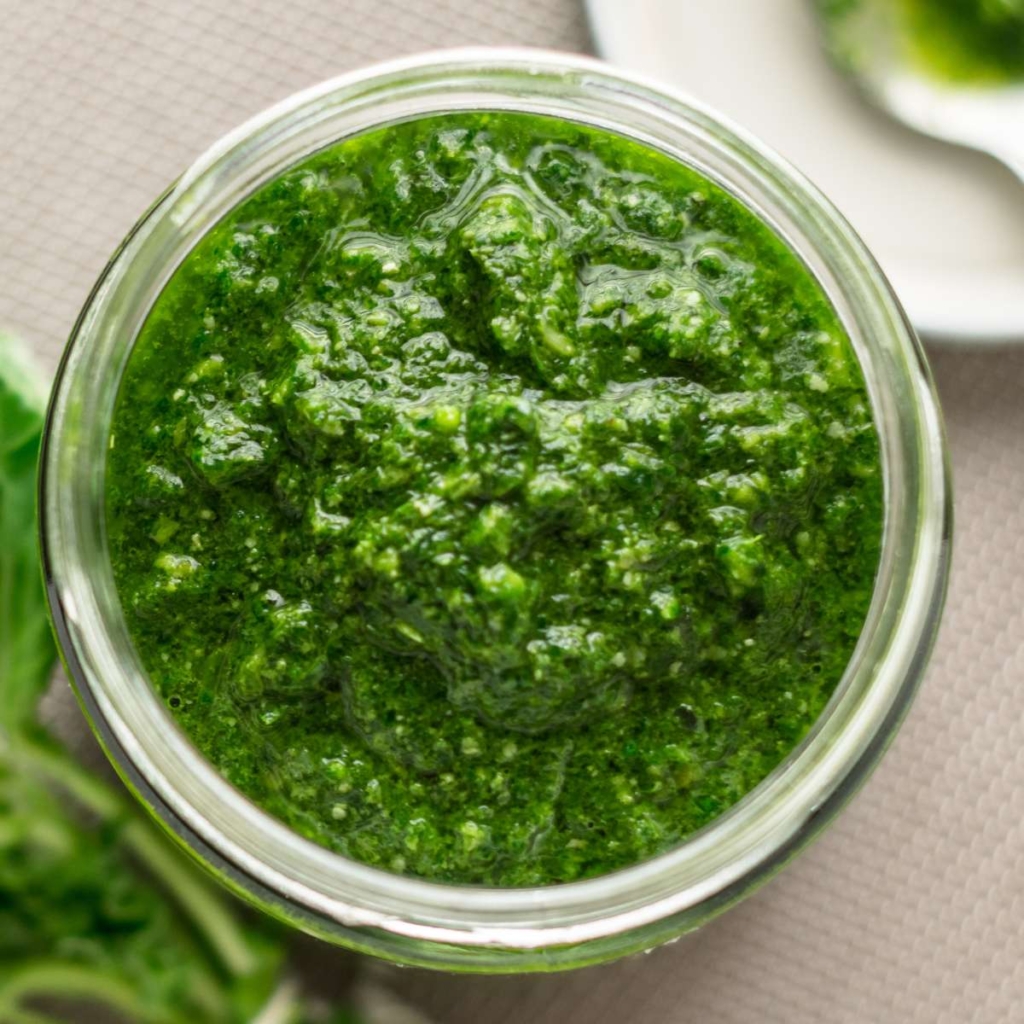What is Pesto? So you’ve decided to venture into the world of Italian cuisine, and you’ve stumbled upon pesto sauce – a herby condiment that has graced dishes for generations.
The aroma of fresh basil and the delicate combination of garlic, pine nuts, Parmesan cheese, and olive oil make this green gold a delicious and versatile addition to pasta, sandwiches, and so much more.
Pesto is not to be confused with chimichurri – pesto is made with a blend of basic, garlic, pine nuts, olive oil and parmesan cheese, whereas chimichurri is parsley (sometimes mint), olive oil, garlic, and oregano. See additional information on this mint based chimichurri sauce, or try a chimichurri with cilantro instead.
Key Points:
- Pesto’s roots lie in Italian cuisine, featuring a blend of basil, garlic, pine nuts, Parmesan cheese, and olive oil.
- This herby condiment is versatile, perfect for pairing with pasta, sandwiches, and countless other dishes.
- Traditional pesto alla Genovese is just the beginning, with countless variations and inspired creations to explore.
A Timeless Trend: The Evolution of Pesto
The concept of pesto extends beyond its classic Genovese version. Originating from Genoa, Italy, the classic pesto alla Genovese has inspired a myriad of pesto variations, showcasing pesto’s adaptability and the range of flavors it can embody.
This diversity highlights the culinary evolution of pesto, inviting both professional chefs and home cooks to explore and redefine what herb sauces can be.
| Classic Pesto | Modern Variations |
|---|---|
| Pesto alla Genovese | Cilantro and sesame pesto |
| Mint-spinach pesto | |
| Mixed herb pesto (parsley, oregano, and thyme) | |
| Asiago or Manchego cheese-based pesto |
Variants like fettuccine with mint-spinach pesto offer a Greek twist to the traditional sauce, while mixed herb pesto brings together parsley, oregano, and thyme for an aromatic blend. With such a wide array of options, the possibilities for new pesto creations appear boundless.
So, go ahead and have fun experimenting with your favorite herbs and nuts to create unique pesto combinations that will delight your palate and those of your guests.
Uncovering the Roots of Pesto: Tradition and Etymology
As a cherished staple of Italian culinary tradition, understanding the etymology of pesto and its historical roots reveals the essence of this versatile sauce. Pesto’s very name traces back to the Italian verb “pestare,” describing the action of pounding or crushing, which is central to its identity and preparation method.
The Linguistic Heritage of Pesto
Traditional pesto is prepared by crushing the ingredients together in a mortar with a pestle. This labor-intensive process results in a luxurious, silky texture that’s been celebrated across generations and is difficult to replicate with modern cooking appliances like food processors.
The etymology of pesto highlights its essence, drawing attention to the importance of honoring the original, time-honored techniques in Italian culinary artistry.
Pesto alla Genovese: The Traditional Touchstone
Pesto alla Genovese, the quintessential pesto variety, is created with a careful blend of fresh basil, garlic, pine nuts, olive oil, and Parmesan cheese. Sometimes, walnuts or Romano cheese are utilized for different textures and flavors.
The precise combination and balance of these ingredients produce a sauce with a harmonious yet distinct flavor profile, where the taste of each component is distinguishable and intensely fresh. This traditional flavor composition reminds us of the importance of simplicity as well as the marvels of authentic Italian culinary creations.
Crafting the Classic: Signature Ingredients of Pesto
In traditional pesto, a blend of carefully chosen, fresh and high-quality ingredients come together to create a tantalizing sauce that is rich in flavor and teeming with character. Let’s dive deeper and explore the central role basil plays in pesto, as well as how other components like garlic, nuts, and Parmesan cheese add depth and sophistication to this classic sauce.
From Garden to Table: Basil’s Central Role
At the heart of pesto lies fresh basil, an aromatic herb that provides the sauce’s iconic color and a significant portion of its flavor profile. This foundational ingredient lends pesto its characteristically fresh and slightly sweet essence, which is enhanced and complemented by the other traditional ingredients.
The use of fresh basil ensures that the pestoist both bright and robust, making it an unmistakable presence in any dish it accompanies.
Adding Depth: Garlic, Nuts, and Parmesan
Garlic, a vital component of many culinary dishes, imparts its pungent and unmistakable taste into pesto. This pantry staple not only elevates the sauce’s flavor profile but also contributes to its characteristic boldness. As for nuts, pine nuts are the traditional choice, though other nuts like walnuts or almonds may be used as well.
These nuts provide a subtle creaminess and richness to the sauce, while simultaneously adding a unique and often unexpected nuance to the overall pesto flavor.
Finally, Parmesan cheese, known for its rich umami, adds a delightful saltiness and nuttiness to the mix. This beloved Italian cheese completes the sauce and ties each element together harmoniously, resulting in a pesto that begs to be savored and shared.
In conclusion, the sumptuous interplay of fresh basil, garlic, nuts, and Parmesan cheese is what makes pesto a timeless classic in the culinary world. Each component serves as a pesto flavor enhancer, combining to create a rich and bold sauce that elevates any dish it graces.
So, as you explore the world of pesto, take the time to appreciate the balance and harmony of these ingredients, each contributing a unique essence to the symphony of flavors that is pesto.
The Distinctive Palate: Identifying Pesto’s Flavor Profile
Pesto’s flavor profile is akin to a symphony where each ingredient plays a critical role, and the final product is far greater than the sum of its parts.
Unlike dishes that meld into a single taste, pesto celebrates the individuality of its components – the herbal intensity of basil, the sharp warmth of garlic, and the creamy bite of pine nuts or similarly texture-rich substitutes like almonds or walnuts.
A Symphony of Ingredients
Understanding the contributions of each ingredient allows for more thoughtful food pairings with pesto. The fresh and potent notes of basil and garlic match well with pastas and bread, while the richness of the nuts and the velvety texture of the cheese beautifully complement more neutral bases such as potatoes or simple grilled chicken, turning ordinary dishes into extraordinary creations.
“Pesto is so versatile and flavorful that it can easily become the star of any dish it is paired with.”
Matching Flavors with Ingredients
Some delightful food pairings that bring out the best pesto taste are:
- Bruschetta – toasted bread, sliced tomatoes, and pesto make for a heavenly appetizer.
- Roasted vegetables – drizzle pesto atop a medley of oven-roasted vegetables for an herby twist.
- Pesto-stuffed chicken – slice a pocket into a chicken breast and fill it with pesto (and cheese, if desired) before baking.
- Pizza – swap your traditional tomato sauce for a layer of pesto.
| Base Ingredient | Pesto Flavor Profile | Perfect Pesto Pairings |
|---|---|---|
| Bread/Pasta | Fresh, Potent Basil & Garlic | Bruschetta, Traditional Pasta |
| Vegetables | Rich, Creamy Nuts & Cheese | Roasted Vegetables, Stuffed Peppers |
| Protein | Herbal, Savory Notes | Pesto-stuffed Chicken, Grilled Shrimp |
| Pizza | Bright Basil, Bold Garlic | Margherita, Veggie, Prosciutto & Arugula |
Give these pairings a try, and unlock the full potential of your homemade pesto. You’ll be amazed at how this herby sauce can elevate your dishes, transforming your meals into truly unforgettable experiences.
Making Pesto with Modern Conveniences
While the creation of pesto has roots in traditional methods, the use of modern kitchen appliances has revolutionized quick pesto preparation without compromising the essence of this beloved sauce.
Two popular techniques for making pesto include the food processor method and the time-honored mortar and pestle technique. Let’s explore the advantages of each method to help you determine your preferred style.
The Food Processor Method
For those who value time and efficiency, the food processor method provides a convenient alternative to the traditional pesto method. This technique involves pulsing garlic, pine nuts, and basil in a food processor and then blending with oil and cheese to achieve a slightly grainy yet consistent texture.
While traditionalists may argue that this method doesn’t offer the same luxurious texture as a mortar and pestle, it does allow for the easy and rapid production of homemade pesto.

Mortar and Pestle Pesto: A Recipe to Remember
In contrast, the mortar and pestle technique is the epitome of traditional pesto preparation, offering an unrivaled depth of flavor and silky texture. This labor-intensive method requires working the ingredients against the mortar’s surface, which enhances the infusion of flavors and results in a velvety and rich paste that the food processor struggles to replicate.
Culinary purists emphasize the superiority of this pesto method, as it honors pesto’s centuries-old heritage and produces exceptional quality.
Mortar and pestle pesto is like a symphony of flavors, with each ingredient playing a critical role in creating an exquisite sauce that is hard to match with modern appliances.
Embracing Alternatives: Creating Vegan Pesto
For those following a plant-based diet, vegan pesto is a delectable way to enjoy the familiar flavors of this classic sauce without the dairy. With a few simple adjustments, you can retain the creamy consistency and tangy zest of the conventional pesto, while embracing a whole new world of vegan variations.
Adjusting the Classics
Vegan pesto can be made by substituting Parmesan with a vegan cheese or nutritional yeast and adding extra nuts along with a bit of water for moisture. Opt for stirring these substitutes in at the end, instead of blending them, to preserve the texture and flavor integrity of the sauce.
Ideas for Vegan Variations
Dairy-free alternatives like vegan pesto offer a plethora of opportunities for creative exploration in the world of pesto flavors. For instance, a cilantro pesto with sesame can integrate vegan cheese or be enhanced with additional herbs, exemplifying the adaptability of pesto to different lifestyles and diets.
These variations maintain the essence of this much-loved sauce while presenting opportunities for diversity and inclusion of flavors in the plant-based culinary palette.
Storing for Longevity
Pesto is a delightful addition to various dishes, but it’s best enjoyed fresh. However, if you have excess or want to save some for future meals, knowing proper pesto storage techniques is crucial. Refrigerating and freezing pesto are effective ways to keep it fresh and flavorful for extended periods, ensuring you can savor this versatile condiment whenever you crave it.

Chill and Preserve: Refrigerating Pesto
Refrigerating your pesto is a simple and practical solution for short-term storage. Place the pesto in an airtight container, ensuring its freshness is locked in. By properly refrigerating condiments like pesto, you can enjoy them for up to a week. This approach works best for those who want to spread their homemade pesto across multiple meal preparations within the week.
Locking in Flavor: Freezing Techniques
For long-term pesto storage, freezing pesto is an excellent method. By packaging it in air-tight containers or resealable freezer bags, squeezing out all the air, your pesto can remain fresh for up to six months. This technique not only preserves its flavors but also prevents spoilage, ensuring that you have a readily available supply of this delectable sauce.
Another freezing method that conserves more flavor and simplifies usage is to fill ice cube trays with pesto to create individual portions. Once frozen, transfer the pesto cubes into freezer bags or air-tight containers. This approach allows for easy thawing of only the necessary amount, reducing waste and maintaining the integrity of the sauce.
The Universal Condiment: Innovative Ways to Use Pesto
In addition to its traditional application in pasta dishes, pesto’s bold flavor profile has found its way into a variety of culinary creations. The following sections explore diverse uses for this herby sauce that demonstrate its versatility and capacity for meal enhancement.
From Pasta to Paninis: Diverse Applications
Eager to diversify your pesto uses? This green sauce can also be spread over sandwiches such as a prosciutto and mozzarella panini or stirred into a bowl of minestrone soup. Its adaptability makes pesto an intriguing and tasty additive in varied culinary settings.
Pesto Pairings
The culinary potential of pesto extends into innovative territories, like using it in place of butter to cook eggs or transforming puff pastry into pesto pinwheels. Embrace your pesto culinary creativity for a quick and easy meal enhancement that breathes new life into familiar dishes and inspires unique dining experiences.

| Meal | Idea | Pesto Used |
|---|---|---|
| Breakfast | Pesto Scrambled Eggs | Classic Basil Pesto |
| Lunch | Caprese Salad with Pesto Drizzle | Sun-Dried Tomato Pesto |
| Snack | Pesto Hummus | Spinach and Walnut Pesto |
| Dinner | Pesto-Stuffed Chicken Breasts | Cilantro and Sesame Pesto |
| Dessert | Pesto Lemon Cookies | Sweet Basil and Lemon Pesto |
Feel inspired to get creative in the kitchen by pairing pesto with a range of dishes. From the traditional applications to unexpected twists, you’re sure to find fresh and exciting ways to elevate your meals with this versatile and delicious condiment.
Expanding Your Pesto Repertoire: A Collection of Recipes
Traditional pesto recipes can serve as a foundation for numerous creative dishes, allowing you to reimagine and customize the classic flavor to suit any palate.
The versatility of pesto-based dishes also makes it an endlessly adaptable and global ingredient, with international pesto variations bringing unique twists to your kitchen. Let’s explore some exciting recipes that blend classic and global flavors.

Reimagining the Classics
Three Cheese Pesto: Add extra richness to the traditional basil pesto by incorporating a mix of Parmesan, Asiago, and Romano cheeses. With these three cheeses, the pesto’s flavor profile becomes deeper and more complex.
Sun-Dried Tomato Pesto: Blend sun-dried tomatoes with fresh basil, pine nuts, garlic, and Parmesan to create a bold, intense, and flavorful sauce that pairs perfectly with pasta, bruschetta, or as a base for pizza.
Mint and Spinach Pesto: For a refreshing and vibrant take on the classic pesto, combine fresh mint leaves, baby spinach, crushed walnuts, feta cheese, olive oil, and a pinch of salt. This versatile sauce goes well with roasted vegetables, summer salads, and grilled meats.
Exploring Global Flavors with Pesto
Cilantro and Sesame Pesto: Aromatic cilantro and roasted sesame seeds blend together to bring an Asian twist to pesto. Paired with rice noodles or roasted vegetables, it creates a deliciously effortless meal.
Argentinian Chimichurri Pesto: This flavorful sauce combines fresh parsley, oregano, and cilantro with garlic, red pepper flakes, and red wine vinegar. Perfect for drizzling over grilled steak, chicken, or fish, this pesto adds a punch of authentic South American flavor to your dishes.
Greek Feta and Olive Pesto: Inspired by the flavors of Greece, combine tangy feta cheese, Kalamata olives, fresh basil, oregano, and olive oil for a bold and briny sauce that pairs wonderfully with pasta, salads, or as a spread for sandwiches and wraps.
These inventive recipes showcase pesto’s ability to blend traditional flavors and international variations, providing endless opportunities for culinary adventure and experimentation. Get creative in your kitchen and see how these global pesto recipes can elevate your cooking repertoire.
Conclusion
The rich history and versatility of pesto sauce make it a testament to the harmony that can be achieved when simple, high-quality ingredients are combined skillfully. While rooted in tradition, pesto continues to be a canvas for culinary innovation, consistently reinventing itself through flavors and ingredients.
Preserving Traditions, Inspiring Innovation
Pesto embraces the balance between preserving its authentic Italian origins and inspiring chefs and home cooks alike to reimagine it in countless ways. This adaptable condiment offers food enthusiasts an avenue to explore new tastes while honoring an enduring culinary tradition.
Pesto: A Testimony to Culinary Versatility
The enduring popularity of pesto sauce speaks to its remarkable versatility. As a testament to the power of fresh, herby goodness, pesto enhances a plethora of dishes across varied culinary landscapes. An indispensable ingredient in the modern kitchen, pesto consistently captivates palates everywhere, proving that a well-crafted sauce can truly elevate any meal.
FAQ
What is the traditional pesto recipe?
Pesto alla Genovese is the traditional pesto variety that includes fresh basil, garlic, pine nuts, olive oil, and Parmesan cheese. Sometimes, walnuts or Romano cheese are used as alternatives for a different texture and flavor.
How do I make pesto with a food processor?
To make pesto with a food processor, pulse the garlic, pine nuts, and basil, then blend with oil and cheese to achieve a consistent yet slightly grainy texture. This method allows for rapid preparation without sacrificing the essence of homemade pesto.
What are some vegan alternatives for traditional pesto?
Vegan pesto can be made by substituting Parmesan cheese with a vegan cheese or nutritional yeast. Extra nuts can be added for creaminess, and a bit of water for moisture. Be sure to stir these substitutes in rather than blending to preserve the sauce’s texture and flavor integrity.
How should I store my homemade pesto?
Pesto can be stored by refrigerating it in an airtight container for up to a week, ensuring its flavors remain vibrant. For longer storage, freezing in airtight containers, resealable freezer bags, or ice cube trays can keep it fresh for up to six months.
What are some creative ways to use pesto?
Pesto can be used as a spread for sandwiches, an addition to soups, a replacement for butter when cooking eggs, or even in pastries like puff pastry pinwheels. Its rich and herbaceous flavor can elevate a variety of meals from familiar dishes to unique culinary creations.
How can I explore global flavors with pesto?
Pesto’s adaptability lends itself to global culinary exploration, with recipes like cilantro and sesame pesto, fettuccine with mint-spinach pesto, or mixed herb pesto with parsley, oregano, and thyme. These international variations highlight the endless possibilities for creating unique and flavorful pesto dishes.



